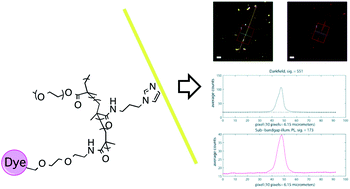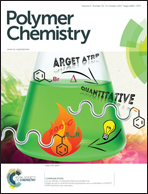Synthesis of random terpolymers bearing multidentate imidazole units and their use in functionalization of cadmium sulfide nanowires
Abstract
This work reports on a new random ternary polymerization method for the synthesis of multidentate imidazole polymers. The polymers can behave as ligands for the functionalization of cadmium sulfide nanowires. Due to the intrinsic differences in the electronegativity of the groups next to the vinyl bond, the vinyl groups displayed unique NMR signals, and allowed for the measurement of the individual monomer conversions in the random terpolymer system. The activated ester bearing terpolymer was postmodified with N-alkyl imidazole units, followed by the boc deprotection of the amine terminal groups. The resulting poly(imid-PEGMA-MAMamine) provided water solubility, dye loading capability as well as the ability to coordinate with metal chalcogenide surfaces using the imidazole units. Upon the attachment of a rhodamine dye, studies were performed to analyze the potential of such polymers to modify CdS nanowires using fluorescence microscopy. The fluorescence microscopy results provided confirmation of the polymeric ligand attachment, and sets the foundation for further optical studies using this system.


 Please wait while we load your content...
Please wait while we load your content...